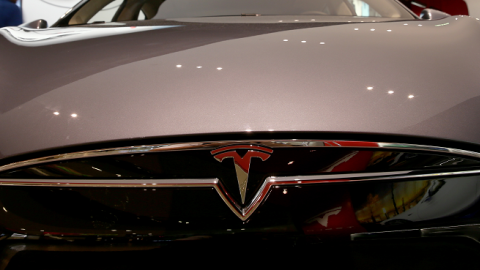"The dinosaurs surviving the crunch” was how Stephen Sondheim described women living an outdated lifestyle and grimly aware that “everybody dies.” If Sondheim had the slightest interest in the less exalted subject of economics, he would apply that descriptive to a host of companies and industries trying to beat the hooded man with a scythe, aided by their regulators.
The most recent example comes to us courtesy of New Jersey’s automobile dealers—with an assist from their regulators and Governor Chris Christie—who have decided to follow the lead of Texas, Maryland, and Virginia and declare that Tesla, the maker of electric cars, has violated state law by attempting to sell its cars through its own network of stores rather than through franchised dealers. The New Jersey Coalition of Automotive Retailers (NJCAR), feeling threatened by a firm that sells fewer cars in a year than General Motors sells in a day, contends that the regulations do nothing more than bring Tesla into line with other manufacturers to create a level playing field, the sort on which beleaguered competitors prefer to compete so long as the referee/regulator is on their team. For “level playing field” read status quo.
If Tesla is allowed to eliminate the middleman, Ford, General Motors, and other manufacturers will follow suit, whines NJCAR. Yes, the consumer would save money, but if Governor Christie allowed this new and possibly more efficient method of distribution to take hold in New Jersey, he would surely lose lots of dealer votes and their financial support. So Christie, no stranger to issues in the transportation sector, told Tesla it can keep its stores as galleries but not discuss price or take orders. Any orders would have to be placed in stores in other states (Texas does not allow any such referrals), which would of course reap the sales taxes associated with the sales. Other states are under pressure from dealer organizations to follow New Jersey’s lead, or at minimum New York’s, where the governor and the legislature have cut a deal to allow Tesla to keep its five stores—but no more.
Tesla does not come to this fight with cleanly scrubbed hands. Elon Musk, its founder, principal shareholder, and CEO, and an important contributor to Obama campaigns and the Democratic party, is not exactly a paragon of free-market virtue. He has received handsome subsidies from the Obama administration both for Tesla and for his SolarCity solar-panel operation, in which Al Gore is involved. (In the world of high-tech, Musk is so highly regarded that Larry Page, cofounder of Google, says he would rather leave his billions to Musk, who can change the world, than to charity.) The Tesla founder decided to sell his much-subsidized, high-priced cars (base model $69,900) from Tesla’s own stores because the product needs detailed explaining by skilled sales people, and because cutting out the middleman seems to Tesla’s managers and shareholders the efficient thing to do. That plan is now under threat.
Then there is the taxi industry. With the exception of the chauffeur-driven elite, the limousine liberals who favor but rarely use public transportation, and the very poor for whom taxis are unaffordable or unwilling to enter their neighborhoods, most Americans rely at times on the taxicabs that cruise city streets in search of fares. To say that in cities such as New York and Washington, D.C., the service leaves something to be desired, is to put it mildly. I served as head of a commission set up by Mayor Ed Koch to reform taxi service in New York, and lost the reform fight to the clout of the fleet owners and drivers who had paid small fortunes for the medallions, the permits to share in the monopoly profits from regulators’ refusal to increase the supply of taxis for decades during which demand soared. Regulators saw it as their role to preserve the monopoly profits, and high fares, that would support the prices paid by owners of the precious, scarce medallions (just as regulators for a long time thought it important to limit access to the floor of the New York Stock Exchange to preserve the value of floor traders’ seats).
Enter Uber and similar services that replace inefficient and emissions-maximizing cruising with pick-up-by-appointment. And begin what Bloomberg's Brad Stone calls “The Invasion of the Taxi Snatchers.” Tap the right app, and a clean vehicle piloted by a polite driver with at least a minimal acquaintance with the English language, and possessed of gadgets that enable him to get you to where you want to go in a more or less direct fashion, and you have a moderately more expensive alternative to the often difficult task of finding an available cab, especially on a rainy evening in the rush hour, when Uber et al. keep their drivers on the road by charging a premium based on the level of demand. Uber too pricey? Try a ride-sharing app such as Lyft or Sidecar. Geoffrey Fowler of the Wall Street Journal organized tests in several cities and found that “over more than 30 rides, we had [ride-sharing] drivers offer us candy, fist bumps, and even mediation coaching. They all got us where we needed to go safely, and almost as quick as a taxi, but not always as cheap.”
All of these services provide a real incentive to courteous service: Riders report their ratings of each driver, and other users can see those ratings when asking for service. The services themselves must vet drivers if they are to stay in business, and report to future customers the less-than-stellar safety habits of any NASCAR wannabes they allow to remain with the company. Ask yourself: Would you rather ride with a driver who has been rated by other passengers, with that rating posted on your cell phone and monitored continuously by a company with a stake in maintaining consumer confidence, or one who has been cleared by some local political appointee who might, just might, see approval of a driver as a source of income?
All this new competition is anathema to regulators, who see their jobs disappearing if enough customers prefer the new, technologically based services to stand-and-hail-and-hope. From the District of Columbia to Seattle, and in cities and states in-between, regulators are rallying to the side of their pet dinosaurs. They want to require Uber to use a payment system that is incompatible with its technology, report all rides to them for analysis, and comply with a host of new regulations designed to drive them (pun intended) from the streets. If apps-based companies send taxis the way of the horse and buggy, regulators, too, will become redundant as the market replaces them as the determinant of just how many vehicles will be on the streets, and who will be driving them.
That is not the only example of consumers seeking alternatives to outmoded business methods that regulators seek to preserve. As banks become less and less willing to lend to small businesses, alternative lenders are emerging—“shadow banks” incumbents and regulators like to call them, implying that these “indistinct financial entities . . . lurk in the dark corners of the financial system,” writes Tracy Alloway in the Financial Times. In fact, she continues, these nontraditional lenders often do what traditional banks do, but “in a cheaper and more efficient way.” There is peer-to-peer lending, provision of capital by cash-rich companies such as Google, a variety of ways to do without the banks that impose such systemic risk on the economy, and new alternatives for the 28.3 percent of households, predominantly low-income, who choose not to rely on the mainstream banking system because it is either too expensive or too inaccessible.
The incumbent banks, their profit margins declining in the face of new competition and more stringent regulation, now see profit in serving the under-banked. Unfortunately, that is not their great strength; witness their overreach when they raised fees on debit cards. So they are counting on their regulator to stop or at least rein in these “dicey” competitors, presumably including rock-solid Walmart, which survived the recent downturn without a government bailout and is expanding financial-service offerings to its mostly low-income customers. The Federal Deposit Insurance Corporation says that the providers of Alternative Financial Services (AFS) “may lack consumer protections.”
I’m with Forbes's Halah Touryalai, who studied the new competition and concludes, “For consumers in the under-banked and unbanked demographic the increased competition is great news.” The only question is how rapidly competition will spread to other sectors now served by traditional banks. Regulators in every sector in which I have been involved, from taxis to airlines to telecoms, always claim they can protect consumers better than consumers can protect themselves, a process that inevitably involves protecting the incumbents with whom the regulators are accustomed to dealing. As the acknowledged dean of regulatory economists, Cornell’s Alfred Kahn, liked to point out, regulators all too often come to see themselves as responsible for the financial viability of the companies they are supposed to regulate in the interests of the public, which makes them take a dim view of new technologies and challengers who threaten the value of the regulated companies’ sunk investment.
The lessons are clear. For traditional incumbents the days of customer abuse are coming to an end: The dinosaurs—filthy taxis, unneeded middlemen, arrogant bankers—are feeling the crunch. But their regulators are attempting to relieve them of the necessity of adapting and improving their customers’ satisfaction.
Fortunately, sooner or later even the most powerful regulator can’t withstand the economic and political pressures to meet or beat competition. Doubt that, and think of the airlines, telcos, and electric utilities whose monopolies have withered either because regulators decided they were no longer needed (Kahn’s Civil Aeronautics Board) or because they were unable to withstand the onslaught of new technology, new entrepreneurs, and a new public awareness of the costs of regulation. Yes, there are situations in which regulation remains necessary, as with nontransient monopoly power and the production of goods that impose costs on society. But they are more the exception than the rule.
The great Joseph Schumpeter wrote that the “animal spirits” of bold entrepreneurs create a “gale of creative destruction” that forces capitalism to shed the old and adopt the new, driving living standards and growth forward. Economic dinosaurs can extend their lives with the aid of their regulators—but sooner or later they will be unable to survive the crunch created by new technology and more efficient forms of economic organization. Sooner, if public policy comes down on the side of competition.
















